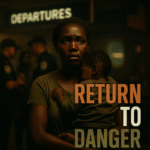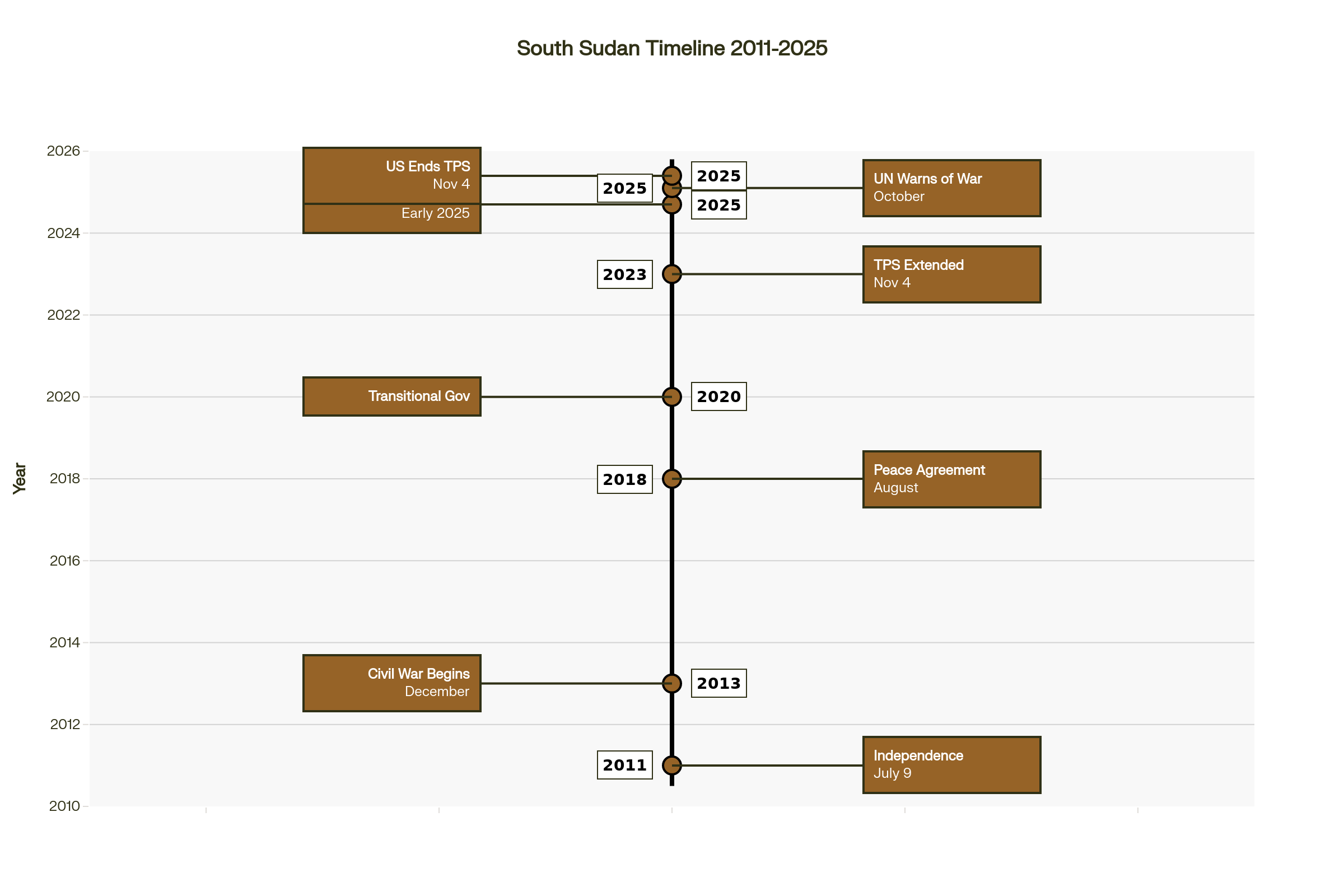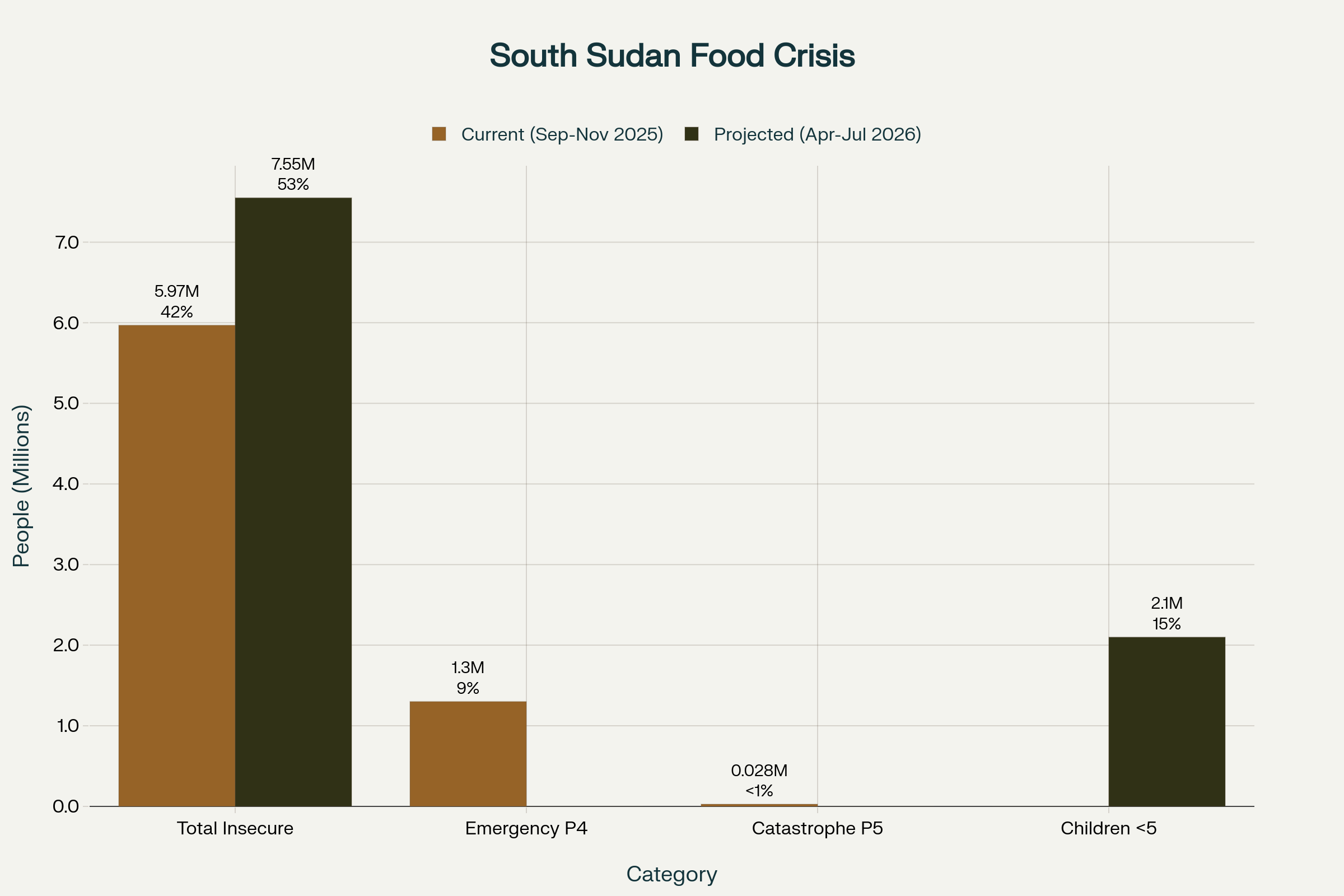

US Ends Deportation Protection for South Sudanese: A Reversal of Hope After 14 Years
The History Behind The Headlines
By Darius Spearman (africanelements.org)
Support African Elements at patreon.com/africanelements and hear recent news in a single playlist. Additionally, you can gain early access to ad-free video content.
When Safety Became Uncertain: The Abrupt End of Protection
In November 2025, the Trump administration delivered devastating news to thousands of South Sudanese people living in the United States. The Department of Homeland Security announced that temporary protected status—a program shielding these individuals from deportation—would end. CBS News reported that approximately 5,000 South Sudanese nationals now have just 60 days to leave America or face deportation back to their war-torn nation. The designation expires on January 5, 2026, marking the end of 14 years of protection for people fleeing one of Africa’s worst humanitarian disasters.

South Sudan’s Journey: A Timeline of Independence, Conflict, and Policy Changes (2011-2025)
The decision represents a stark policy reversal. Temporary Protected Status (TPS) for South Sudan was most recently renewed for 18 months from November 4, 2023, to May 3, 2025, by then-DHS Secretary Alejandro Mayorkas under the Biden administration. It was then automatically extended for six months through November 3, 2025, after DHS did not complete a required review in time. The termination announcement came under DHS Secretary Kristi Noem.
The Contradiction Between Policy and Reality
The government’s reasoning contradicts what international observers are witnessing. DHS stated that “renewed peace in South Sudan” and “improved diplomatic relations” justify the termination. However, the United Nations issued far more alarming warnings just weeks before this announcement. A UN commission on human rights declared that South Sudan’s “political transition is falling apart,” with the ceasefire crumbling and “all indicators point to a slide back toward another deadly war.” Moreover, the State Department maintains a Level 4 “Do Not Travel” advisory for South Sudan, citing persistent armed conflict, crime, and kidnapping.
Food insecurity tells the most brutal part of this story. According to UN hunger monitoring, nearly 6 million South Sudanese people currently face acute food insecurity as of November 2025. This number will skyrocket to 7.55 million during the lean season from April to July 2026. More than two million children under five risk severe malnutrition, and approximately 28,000 people face catastrophic hunger conditions with a real risk of famine.

South Sudan’s Food Insecurity Crisis: Current Conditions and Projected Outlook for 2026
The Trump administration is offering incentives for voluntary departure, including free airline tickets, \$1,000 exit bonuses, and promises of “future pathways for legal immigration”—though officials have not detailed what these pathways might entail. Yet these financial inducements cannot change the fundamental reality: sending these individuals back to South Sudan defies basic humanitarian principles.
The Roots of Displacement: Understanding South Sudan’s Tragedy
South Sudan’s story begins with hope that quickly became nightmare. In 2011, after decades of brutal conflict between North and South Sudan, South Sudanese overwhelmingly voted for independence. Nearly 99 percent of voters chose freedom, creating the world’s newest nation on July 9, 2011. The celebration, however, lasted barely two years.
In December 2013, political tensions between President Salva Kiir and Vice President Riek Machar erupted into open warfare. What started in the capital city of Juba quickly spread across the country. This civil war resulted in approximately 400,000 deaths between 2013 and 2018, though some estimates place the toll even higher. More than four million people fled their homes, becoming refugees or internally displaced persons. The violence included ethnic massacres, child soldier recruitment, widespread rape used as a weapon of war, and systematic killings of civilians.
The international community responded with humanitarian concern. A peace agreement was signed in August 2018 between the warring factions, creating a transitional government meant to move the nation toward elections and stability. For a moment, the violence seemed to be subsiding. Yet observers knew the peace remained fragile, held together more by exhaustion than genuine reconciliation.
During this period of transition, the Obama administration had designated South Sudan for Temporary Protected Status in 2011, recognizing the extraordinary and temporary conditions preventing safe return. Multiple presidential administrations, both Democratic and Republican, renewed the protection as conditions remained dire. The program became a lifeline for South Sudanese people seeking refuge in America.
When Peace Becomes Illusion: The Return of Conflict
The fragile 2018 peace agreement was never meant to last forever. Early in 2025, First Vice President Riek Machar was arrested on treason charges and placed under house arrest. This dramatic action signaled a collapse of the power-sharing arrangement. UN investigators documented that fighting has intensified since March 2025, displacing over 370,000 civilians internally and driving many more across borders into neighboring countries.
The violence reflects the underlying ethnic and political divisions that the 2018 agreement papered over but never resolved. Since 2011, South Sudan has endured endless cycles of conflict, with peace agreements repeatedly failing to address root grievances or rebuild the state institutions destroyed by war. Weak governance, corruption, and ethnic polarization continue to plague the nation. These structural problems cannot be fixed through diplomatic agreements alone.
The humanitarian consequences are staggering. Nearly three-quarters of South Sudan’s population—approximately 9 million people—require humanitarian assistance, according to UN and Congressional research. The country’s health system has collapsed. Education has been disrupted for an entire generation of children. Economic activity has virtually ceased, leaving the nation dependent on foreign aid.
The Historical Context: Colonial Legacies and Ongoing Exploitation
Understanding South Sudan’s tragedy requires looking further back than 2011. The roots of South Sudan’s suffering stretch deep into the colonial era. For nearly a century, Britain and Egypt controlled Sudan as a colonial possession, but they governed the North and South differently. The North was integrated into Arab Islamic culture and governance, while the South was largely left underdeveloped and treated as a source of labor and resources.
When Sudan gained independence in 1956, these colonial divisions hardened into a system of north-south exploitation. The wealthier Arabic-speaking North dominated the government and economy, while the predominantly Black African South was marginalized and discriminated against. The Second Sudanese Civil War, lasting from 1983 to 2005, emerged from this structural inequality. Approximately two million people died in that conflict due to war, famine, and disease. Slavery was even revived as a weapon of war, with Arab militias enslaving southern prisoners based on Islamic law.
This previous civil war’s brutality created the conditions for South Sudan’s independence. When the 2005 Comprehensive Peace Agreement ended the fighting, it promised a referendum on southern independence. Six years later, that referendum happened. Nearly everyone in the South voted to leave, understandably seeking escape from northern domination.
When Independence Brought More War: The 2013 Conflict
Yet independence did not bring the peace that South Sudanese desperately needed. Instead, the young nation faced immediate challenges. Weak state institutions, competing ethnic groups, and a political leadership lacking experience in peaceful governance created conditions for renewed violence. The civil war that began in December 2013 unleashed atrocities that matched the brutality of the previous war. The Sudan People’s Liberation Army under Kiir and the SPLA-In Opposition under Machar, along with numerous ethnic militias, perpetrated extrajudicial killings, torture, child abductions, and massive sexual violence against civilian populations.
The 2013-2018 war created a diaspora as people fled in every direction seeking safety. Hundreds of thousands escaped to neighboring countries like Uganda, Kenya, and Ethiopia. Others made the dangerous journey across continents, seeking refuge in the United States and other Western nations. Between 2011 and now, South Sudan has produced approximately 600,000 refugees, in addition to 2.6 million internally displaced people still trapped in the country.
The Black diaspora community emerging from South Sudan carries the scars of this violence. Many have family members still trapped in South Sudan, facing daily threats to their survival. They send money home to support relatives living in camps or displaced communities. They worry constantly about whether their loved ones will survive the next outbreak of violence.

Understanding the Basics: Key Terms in the South Sudan TPS Story
The Peace Agreement That Failed to Bring Peace
The 2018 peace agreement seemed like a turning point. Kiir and Machar signed a power-sharing arrangement in August 2018, creating a transitional government that was supposed to hold elections and establish permanent democratic institutions. International donors celebrated the deal as a major diplomatic achievement. The agreement promised a path toward stability, with a unified military, a coalition cabinet, and scheduled national elections.
In reality, the agreement was never fully implemented. Key provisions were systematically violated by all sides. The military was never truly unified, with loyal forces remaining separate from opposition soldiers. Political detentions became routine, with government opponents arrested on vague charges. Ethnic tensions continued to simmer just beneath the surface. The promised elections never happened.
Today’s Betrayal: Why Timing Matters
The timing of the Trump administration’s TPS termination is particularly cruel. The UN warns that South Sudan risks sliding back into another full-scale civil war, with recent arrests of key opposition figures suggesting the government is abandoning even the pretense of power-sharing. Violence has intensified dramatically since March 2025. Yet the administration claims conditions have improved sufficiently to warrant ending protections.
This contradiction reveals something important about how the Trump administration views immigration from Africa and the diaspora. Since taking office in January 2025, the administration has terminated TPS for multiple countries, including Haiti, Syria, Venezuela, and others—predominantly nations of Black and Brown people fleeing violence. A DHS spokesperson claimed that TPS “was exploited to admit violent terrorists, criminals, and national security threats,” despite evidence that TPS holders commit crimes at lower rates than the general population.
What This Means for Black Communities and the Diaspora
For African Americans and the broader Black diaspora in the United States, this policy matters deeply. Many African Americans have family connections to Africa, whether through recent immigration or ancestral heritage. The termination of South Sudan’s TPS status sends a message about how the U.S. government values Black lives, particularly Black lives from Africa.
The South Sudanese community in America has worked hard to build new lives. TPS holders have contributed billions in wages and taxes to the American economy, with over 94 percent of TPS holders in the labor force. South Sudanese people work in healthcare, education, construction, and service industries. They pay taxes and send their children to American schools. They have become part of their communities.
Yet none of this achievement guarantees their safety or future. One political decision can strip away everything they have built. The South Sudanese community faces the same threat that has haunted the African American experience throughout American history: the constant possibility of state-sanctioned removal and displacement.
Importantly, this policy also affects the relationships between African immigrants and African Americans. Some research suggests that tensions exist between these communities due to stereotyping and cultural differences. However, both groups share fundamental experiences of racial discrimination, forced displacement, and marginalization by the U.S. state. The South Sudanese who will be deported are being sent back to the same conditions that forced them to flee in the first place. The American state that promised them safety is now forcing them into danger.
Why This Moment Demands Attention and Action
The termination of South Sudan’s TPS designation is not merely an immigration policy issue. It represents a fundamental retreat from humanitarian responsibility and human rights obligations. The United States has historically been a signatory to international conventions against torture and the principle of non-refoulement—the prohibition against returning people to places where they face persecution or death.
Sending 5,000 people back to South Sudan defies these commitments. It ignores the warnings from the United Nations, humanitarian organizations, and independent observers that conditions are deteriorating. It prioritizes narrow political goals over human dignity and survival.
For the South Sudanese diaspora in America, this decision feels like abandonment. After fourteen years of protection, after building lives and careers, after contributing to their communities, they face the prospect of losing everything. More importantly, they face the prospect of being sent back to a nation teetering on the edge of renewed civil war.
The broader implications concern the future of the international refugee and asylum system. If the United States can terminate TPS for South Sudan despite clear evidence of ongoing violence and humanitarian catastrophe, then the program’s protections become meaningless. Every country facing conflict must now wonder whether American protection is permanent or merely temporary, subject to changing political winds.
Looking Forward: The Uncertain Path Ahead
Some South Sudanese TPS holders will undoubtedly challenge the termination in court. Immigration advocates have already launched legal battles against other TPS terminations in 2025. The courts may block or delay the termination, as they did with previous Trump administration efforts in his first term. However, even if successful litigation delays the process, it will not solve the fundamental problem: a government that views African immigrants with skepticism and suspicion.
The South Sudanese community in America faces difficult choices in the coming months. Some may voluntarily depart, especially if the promised incentives and future immigration pathways materialize as advertised. Others will remain and risk deportation, hoping that legal challenges succeed or that political circumstances change. Still others will face impossible decisions about separating from family members who may have different immigration statuses.
What is clear is that this moment reveals important truths about American immigration policy and its relationship to Black people and African nations. When America decides that humanitarian concerns matter less than political ideology, vulnerable populations pay the price.
ABOUT THE AUTHOR
Darius Spearman has been a professor of Black Studies at San Diego City College since 2007. He is the author of several books, including Between The Color Lines: A History of African Americans on the California Frontier Through 1890. You can visit Darius online at africanelements.org.
